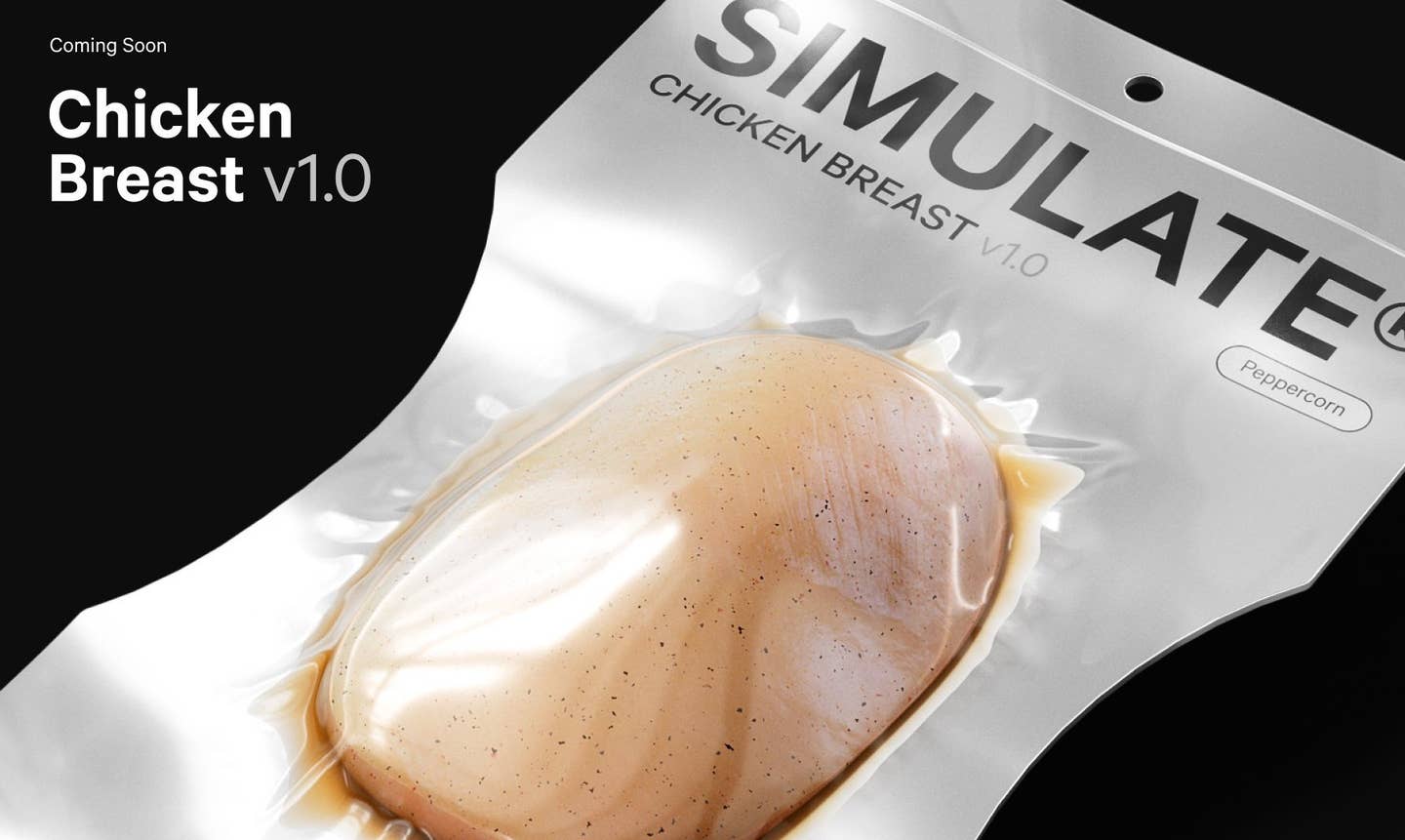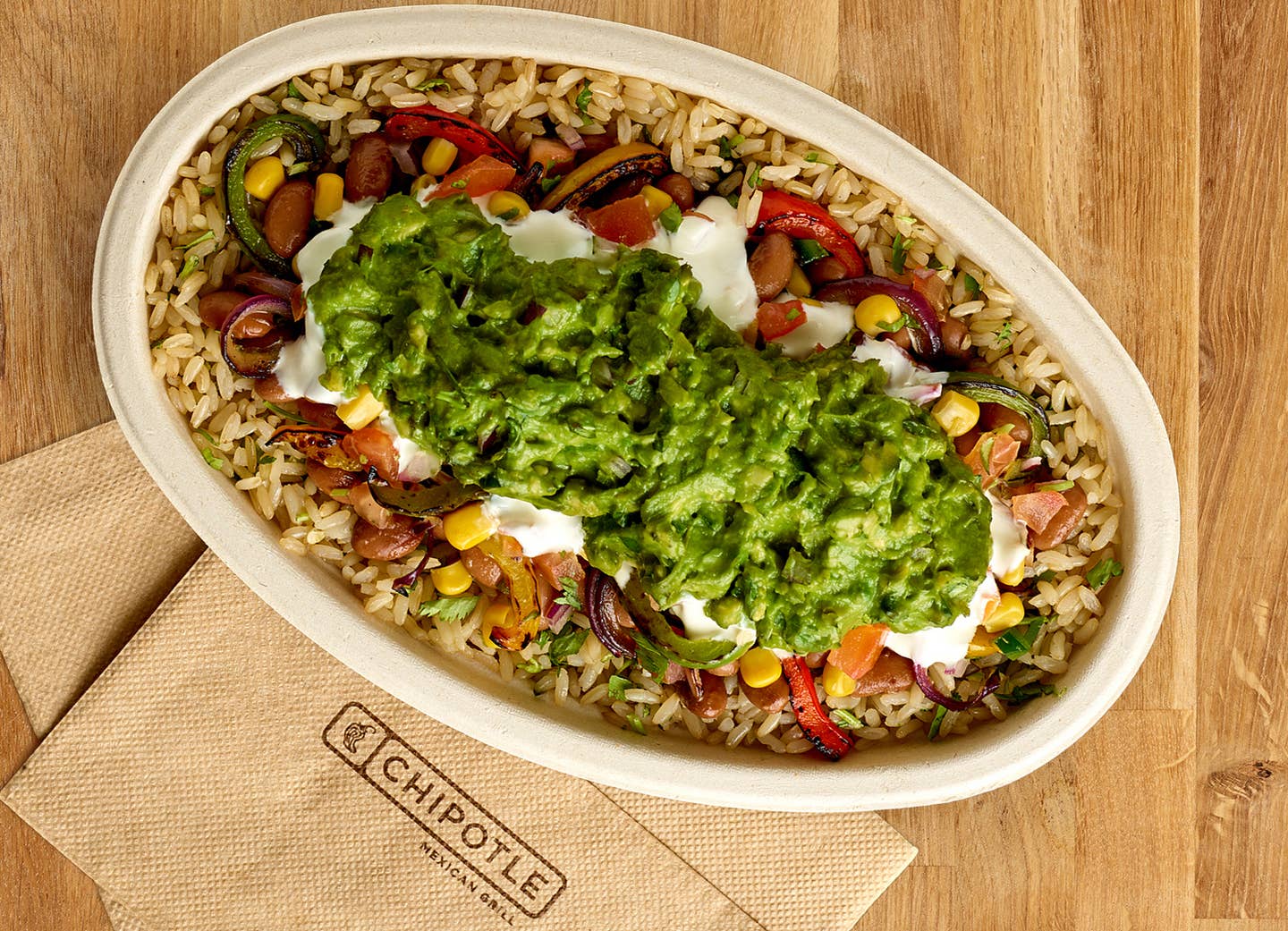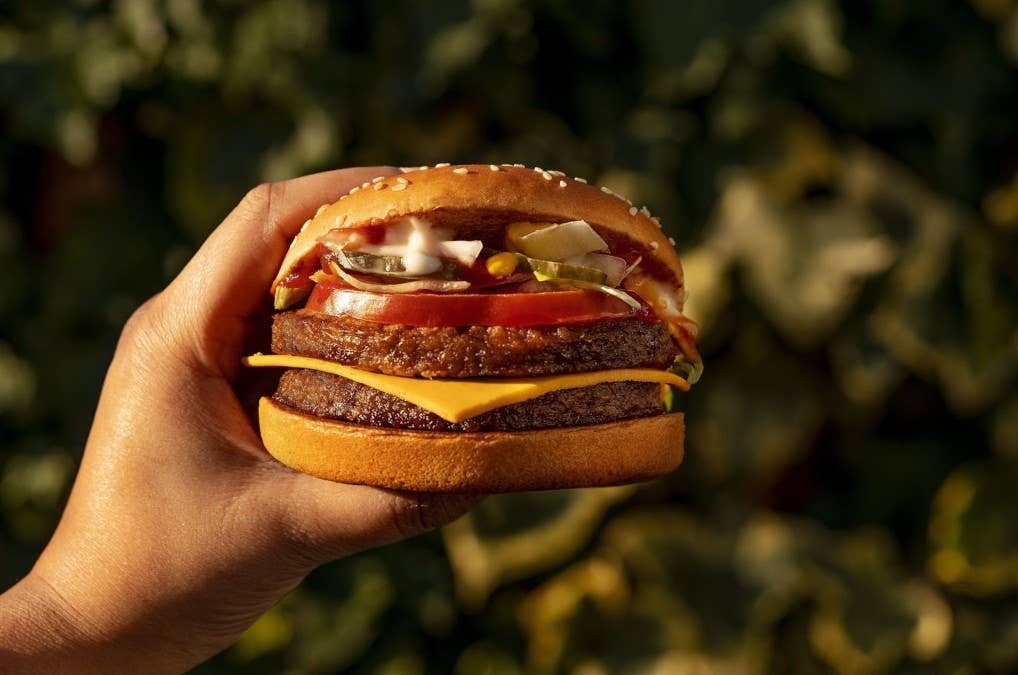
The Maker of Nuggs Teases First-Ever Vegan Chicken Breast
Chicken accounts for 43 percent of the meat consumed by Americans, making it the country's favorite animal-based food. Food tech company Simulate intends to lower this number by producing plant-based products that appeal to meat-eaters worldwide. This week, Simulate teased the world's first fully plant-based chicken breast alternative on its Instagram.
Simulate revealed few details about the innovative meat alternatives, not yet divulging ingredients or nutritional information. But the company noted that shoppers can expect to see the Simulated Chicken Breast by early 2023.
The company's current vegan chicken selection uses a proprietary blend of soybean oil, wheat protein, and soy protein to replicate conventional chicken products. The company initially gained popularity with NUGGS, catching the attention of investors including Jay-Z and Reddit co-founder Alexis Ohanian as well as influencers such as Bella Hadid.
Simulate Debuts Vegan Chicken in Restaurants
This announcement closely follows the company's decision to pivot to restaurant-designated products. This September, Simulate unveiled its plant-based cutlet and strips. The Cutlets replicate traditional fried chicken sandwich meat and the Strips provide home cooks and chefs with a grilled chicken substitute. The products use a new technology that applies heat and pressure to plant proteins to create fibrous, near-identical plant-based meat.
“It’s important for fibrous products, like Strips, and enables a really accurate, muscle-like simulation,” Pasternak said to TechCrunch. “High moisture extrusion is the first of a few technologies that we’ve been building and we’re excited to share more later this year.”
Simulate aims to develop products that appeal to food service brands, giving customers accessible plant-based options. Both new plant-based chicken products are designed with restaurant usability at the forefront.
“When we first launched Nuggs, they were only available on DTC via our website,” Pasternak continued “After we had much success with DTC, we transitioned to retail where the vast majority of our revenue comes from today. Now, we’re entering the next evolution of Simulate, where we’re primarily focused on building a heavy presence in restaurants.”
Simulates vegan chicken products can now be found at 12,000 retail locations worldwide. The company revealed that its year-over-year retail presence has increased by 140 percent. Now, the innovative brand intends to pivot to the food service sector with products such as its plant-based chicken breast. The company is currently valued at $260 million.
Read More: The Beet's Favorite Vegan Chicken Nuggets
Near-Identical Meat Substitutes Made From Plants
Meat and dairy products only provide the world with 18 percent of its total calories, but animal agriculture requires 83 percent of the planet's available farmland to produce. Despite growing environmental pressures, consumers are only gradually adopting plant-based eating, so companies such as Simulate are attempting to appeal to meat-eaters with near-identical vegan meat products.
Even though Simulate revealed the first plant-based chicken breast, several other brands have debuted near-identical alternatives to beef and steak products. This week, Juicy Marbles revealed a fully plant-based Whole-Cut Loin. The company debuted this innovative product shortly after launching its vegan filet mignon in the United States, which received a full endorsement from pop icon Lizzo.
For more plant-based happenings, visit The Beet's News articles.
Top 10 Sources of Plant-Based Protein According to a Nutritionist
1. Seitan
Protein: 21 grams in ⅓ cup (1 ounce) Seitan isn’t as popular as other proteins, but it should be! Made from wheat gluten, its texture resembles ground meat. It’s often used in pre-made veggie burgers or meatless nuggets. Seitan has a savory taste, like mushrooms or chicken, so it works well in dishes that call for an umami flavor. With a hearty texture, seitan can be the star of practically any vegan main dish. Add it to stir-fries, sandwiches, burritos, burgers, or stews. Like tofu, seitan will take on the flavor of any marinade or sauce.
2. Tempeh
Protein: 16 grams in 3 ounces If you like a protein with a bit of bite, add tempeh to your list. Made from fermented soybeans, tempeh has a slightly nutty flavor and is pressed into a block. Most varieties include some sort of grains, such as barley or millet. Not only is tempeh a plant-based source of protein, but the fermentation process also creates good-for-your-gut probiotics. You can cut tempeh right off the block and use it as the base for a sandwich or pan-fry it with some sauce. Or, crumble, heat, and make it the star of your next taco night.
3. Lentils
Protein: 13 grams in ½ cup cooked Lentils come in multiple varieties--red, yellow, green, brown, black. Regardless of the type lentils are small but mighty nutritional powerhouses. They pack a good amount of protein as well as iron, folate, and fiber. When cooked, brown lentils retain their texture and can be the base for a grain bowl or make a hearty substitute for ground meat in meatballs, lasagna, tacos or Bolognese. Red lentils are a bit softer and make a nice add-in for a hearty soup, chili, or stew.
4. Hemp Seeds
Protein: 10 grams in 3 tablespoons Hemp seeds are a tender and nutty seed, derived from the hemp plant. They contain good amounts of omega-3s, iron, folate, magnesium, phosphorus, and manganese. They are also a solid source of both soluble and insoluble fiber, which helps to keep your digestive tract healthy and humming. Because they pack a double whammy of protein and healthy fats, hemp seeds can help satisfy hunger, preventing those embarrassing stomach growls as you slog your way to your lunch break. Add them to your morning smoothie or sprinkle them on top of yogurt, oatmeal, or even a salad.
5. Tofu
Protein: 9 grams in 3 ounces (⅕ of a block) Made from coagulated soybeans, tofu is the most popular plant-based protein. Soy is one of the only meatless "complete" proteins, meaning that it contains all of the essential amino acids that the body can’t make but needs for muscle and immune function. With 15% of your daily calcium needs, tofu is also a good replacement for dairy.
6. Edamame
Protein: 9 grams of protein in ½ cup This sushi appetizer is a nutrient powerhouse, so eat it anytime. Edamame is really just another name for soybeans in their pods. Let’s list off some stats--a small ½-cup serving of edamame has 9 grams of protein, 15% of your daily vitamin C, 10% of your daily iron and 16% of your daily fiber. Keep a bag of edamame in your freezer to serve as a fun-to-eat side dish or opt for the shelled variety to toss into salads or a grain bowl.
7. Quinoa
Protein: 8 grams per cup (cooked) Quinoa is an ancient grain and since it's gluten-free a great choice for anyone avoiding gluten. Add it to your burger recipe to create filling texture, or instead of meat in your taco or burrito. Quinoa is among the healthiest foods on the planet, delivering phytonutrients that have anti-inflammatory qualities, so keep it in your pantry for any meal that needs a filling grain. Just remember to soak it and rinse before cooking to get rid of any bitter taste.
8. Black Beans
Protein: 7 grams in ½ cup (canned) Eating beans on the regular might as well be a prerequisite for a plant-based diet. Not only are canned black beans inexpensive, but they also contribute 10% of your daily iron and 25% of your daily fiber to your diet. For less than $1 a can, beans can be the star of tacos, quesadillas, salads, soups, burgers, or dips.
9. Amaranth
Protein: 6 grams in ⅔ cup (cooked) Chances are you’ve never cooked amaranth. But you should, since this tiny, gluten- free grain is packed with almost 30% of your daily fiber and 20% of your daily iron. Cook it like a traditional grain to yield a soft, porridge-like texture. Many people add amaranth to other a hot breakfast cereal mixture, like oats and quinoa. It also pops like popcorn. Toss it in a pot with some oil and wait for it to pop up into a nutritious snack.
10. Peas
Protein: 5 grams in ⅔ cup If peas were one of your most hated veggies as a kid, it’s time to give them another chance. These green beans are a great low-calorie protein to keep in your freezer. Sure, they don’t always taste great when steamed or microwaved (who wants to eat mushy, overcooked peas?), but they do blend well into a yummy puree that can be slathered on toast. To amp up the flavor, add some lemon juice or mint to your mix before you blend.
More From The Beet






